Product Info Summary
| SKU: | M00004-2 |
|---|---|
| Size: | 100 μg/vial |
| Reactive Species: | Human, Mouse, Rat |
| Host: | Mouse |
| Application: | Flow Cytometry, IF, IHC, ICC, WB |
Customers Who Bought This Also Bought
Product info
Product Name
Anti-beta Catenin CTNNB1 Antibody Picoband® (monoclonal, 1F6)
View all beta-Catenin Antibodies
SKU/Catalog Number
M00004-2
Size
100 μg/vial
Form
Lyophilized
Description
Boster Bio Anti-beta Catenin CTNNB1 Antibody Picoband® (monoclonal, 1F6) catalog # M00004-2. Tested in Flow Cytometry, IF, IHC, ICC, WB applications. This antibody reacts with Human, Mouse, Rat. The brand Picoband indicates this is a premium antibody that guarantees superior quality, high affinity, and strong signals with minimal background in Western blot applications. Only our best-performing antibodies are designated as Picoband, ensuring unmatched performance.
Storage & Handling
Store at -20˚C for one year from date of receipt. After reconstitution, at 4˚C for one month. It can also be aliquotted and stored frozen at -20˚C for six months. Avoid repeated freeze-thaw cycles.
Cite This Product
Anti-beta Catenin CTNNB1 Antibody Picoband® (monoclonal, 1F6) (Boster Biological Technology, Pleasanton CA, USA, Catalog # M00004-2)
Host
Mouse
Contents
Each vial contains 4mg Trehalose, 0.9mg NaCl, 0.2mg Na2HPO4, 0.05mg NaN3.
Clonality
Monoclonal
Clone Number
1F6
Isotype
Mouse IgG1
Immunogen
E. coli-derived human beta Catenin recombinant protein (Position: A2-K233).
*Blocking peptide can be purchased. Costs vary based on immunogen length. Contact us for pricing.
Cross-reactivity
No cross-reactivity with other proteins.
Reactive Species
M00004-2 is reactive to CTNNB1 in Human, Mouse, Rat
Reconstitution
Add 0.2ml of distilled water will yield a concentration of 500ug/ml.
Observed Molecular Weight
95 kDa
Calculated molecular weight
14377 MW
Background of beta-Catenin
Catenins are proteins found in complexes with cadherin cell adhesion molecules of animal cells. The first two catenins that were identified became known as alpha-catenin and beta-catenin. Alpha-catenin can bind to beta-catenin and can also bind actin. Beta-catenin binds the cytoplasmic domain of some cadherins. Beta-catenin is an adherens junction protein. It plays an important role in various aspects of liver biology including liver development (both embryonic and postnatal), liver regeneration following partial hepatectomy. HGF-induced hepatpomegaly, liver zonation, and pathogenesis of liver cancer.
Antibody Validation
Boster validates all antibodies on WB, IHC, ICC, Immunofluorescence, and ELISA with known positive control and negative samples to ensure specificity and high affinity, including thorough antibody incubations.
Application & Images
Applications
M00004-2 is guaranteed for Flow Cytometry, IF, IHC, ICC, WB Boster Guarantee
Assay Dilutions Recommendation
The recommendations below provide a starting point for assay optimization. The actual working concentration varies and should be decided by the user.
Western blot, 0.1-0.5μg/ml
Immunohistochemistry (Paraffin-embedded Section), 0.5-1μg/ml
Immunocytochemistry/Immunofluorescence, 2μg/ml
Flow Cytometry (Fixed), 1-3μg/1x106 cells
Positive Control
WB: human Hela whole cell, human HepG2 whole cell, human MCF-7 whole cell, human A431 whole cell, human RT4 whole cell, human T-47D whole cell
IHC: human mammary cancer, human mammary cancer
ICC/IF: A431 cell
ICC: A549 Cell
FCM: SiHa cell
Validation Images & Assay Conditions

Click image to see more details
Figure 1. Western blot analysis of beta Catenin using anti-beta Catenin antibody (M04085-1).
Electrophoresis was performed on a 5-20% SDS-PAGE gel at 70V (Stacking gel) / 90V (Resolving gel) for 2-3 hours. The sample well of each lane was loaded with 30 ug of sample under reducing conditions.
Lane 1: human Hela whole cell lysates,
Lane 2: human HepG2 whole cell lysates,
Lane 3: human MCF-7 whole cell lysates,
Lane 4: human A431 whole cell lysates,
Lane 5: human RT4 whole cell lysates,
Lane 6: human T-47D whole cell lysates.
After electrophoresis, proteins were transferred to a nitrocellulose membrane at 150 mA for 50-90 minutes. Blocked the membrane with 5% non-fat milk/TBS for 1.5 hour at RT. The membrane was incubated with mouse anti-beta Catenin antigen affinity purified monoclonal antibody (Catalog # M04085-1) at 0.5 μg/mL overnight at 4°C, then washed with TBS-0.1%Tween 3 times with 5 minutes each and probed with a goat anti-mouse IgG-HRP secondary antibody at a dilution of 1:10000 for 1.5 hour at RT. The signal is developed using an Enhanced Chemiluminescent detection (ECL) kit (Catalog # EK1001) with Tanon 5200 system. A specific band was detected for beta Catenin at approximately 95 kDa. The expected band size for beta Catenin is at 85 kDa.
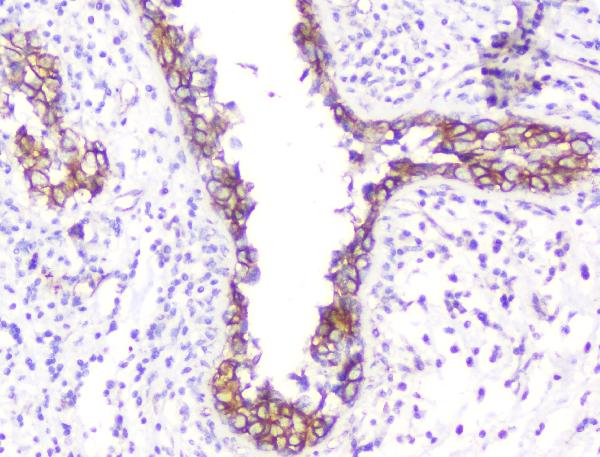
Click image to see more details
Figure 2. IHC analysis of beta Catenin using anti-beta Catenin antibody (M00004-2).
beta Catenin was detected in paraffin-embedded section of human mammary cancer . Heat mediated antigen retrieval was performed in citrate buffer (pH6, epitope retrieval solution) for 20 mins. The tissue section was blocked with 10% goat serum. The tissue section was then incubated with 2μg/ml mouse anti-beta Catenin Antibody (M00004-2) overnight at 4°C. Biotinylated goat anti-mouse IgG was used as secondary antibody and incubated for 30 minutes at 37°C. The tissue section was developed using Strepavidin-Biotin-Complex (SABC)(Catalog # SA1021) with DAB as the chromogen.
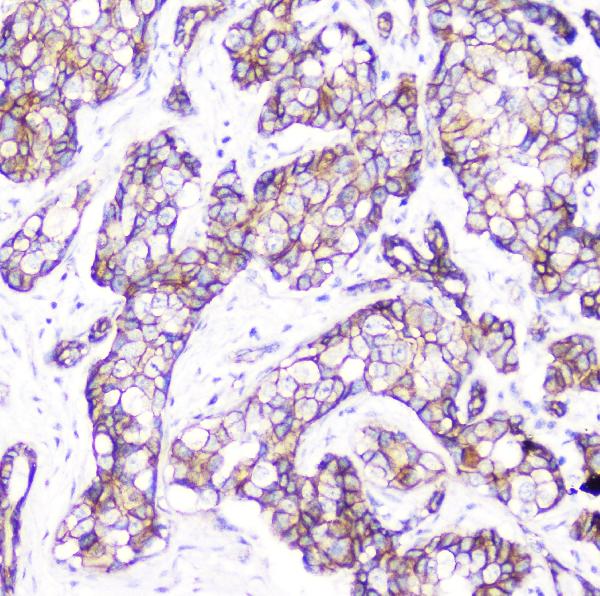
Click image to see more details
Figure 3. IHC analysis of beta Catenin using anti-beta Catenin antibody (M00004-2).
beta Catenin was detected in paraffin-embedded section of human mammary cancer . Heat mediated antigen retrieval was performed in citrate buffer (pH6, epitope retrieval solution) for 20 mins. The tissue section was blocked with 10% goat serum. The tissue section was then incubated with 2μg/ml mouse anti-beta Catenin Antibody (M00004-2) overnight at 4°C. Biotinylated goat anti-mouse IgG was used as secondary antibody and incubated for 30 minutes at 37°C. The tissue section was developed using Strepavidin-Biotin-Complex (SABC)(Catalog # SA1021) with DAB as the chromogen.
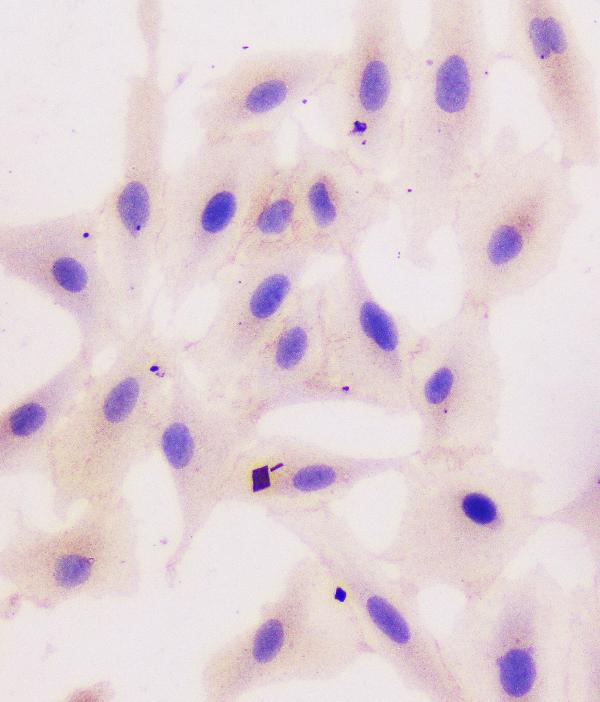
Click image to see more details
Figure 4. IHC analysis of beta Catenin using anti-beta Catenin antibody (M00004-2).
beta Catenin was detected in immunocytochemical section of A549 cell. Enzyme antigen retrieval was performed using IHC enzyme antigen retrieval reagent (AR0022) for 15 mins. The cells were blocked with 10% goat serum. And then incubated with 1μg/ml mouse anti-beta Catenin Antibody (M00004-2) overnight at 4°C. Biotinylated goat anti-mouse IgG was used as secondary antibody and incubated for 30 minutes at 37°C. The section was developed using Strepavidin-Biotin-Complex (SABC)(Catalog # SA1021) with DAB as the chromogen.
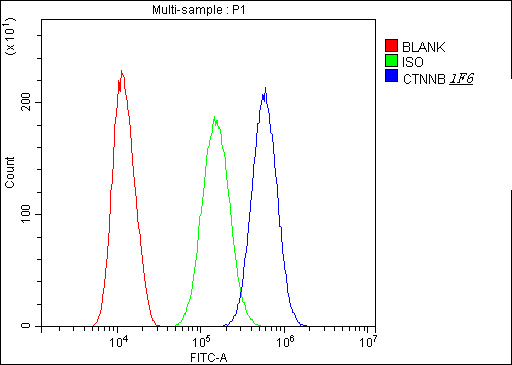
Click image to see more details
Figure 5. Flow Cytometry analysis of SiHa cells using anti-beta Catenin antibody (M00004-2).
Overlay histogram showing SiHa cells stained with M00004-2 (Blue line). The cells were fixed with 4% paraformaldehyde and blocked with 10% normal goat serum. And then incubated with mouse anti-beta Catenin Antibody (M00004-2,1μg/1x106 cells) for 30 min at 20°C. DyLight®488 conjugated goat anti-mouse IgG (BA1126, 5-10μg/1x106 cells) was used as secondary antibody for 30 minutes at 20°C. Isotype control antibody (Green line) was mouse IgG (1μg/1x106) used under the same conditions. Unlabelled sample (Red line) was also used as a control.
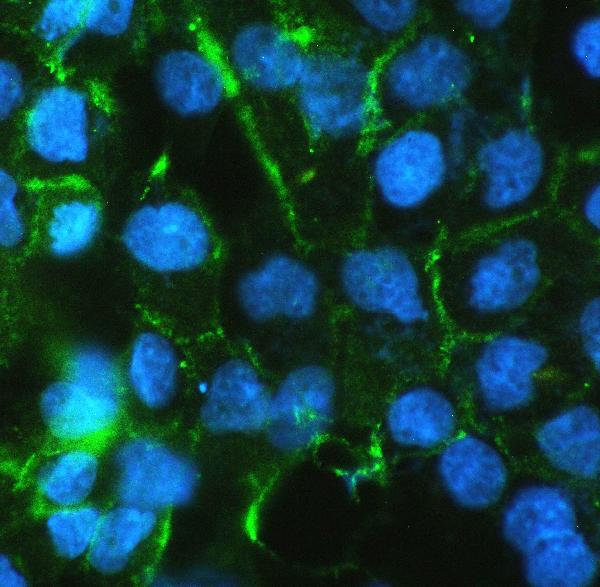
Click image to see more details
Figure 6. IF analysis of beta Catenin using anti-beta Catenin antibody (M00004-2).
beta Catenin was detected in immunocytochemical section of A431 cell. Enzyme antigen retrieval was performed using IHC enzyme antigen retrieval reagent (AR0022) for 15 mins. The cells were blocked with 10% goat serum. And then incubated with 2μg/mL mouse anti-beta Catenin Antibody (M00004-2) overnight at 4°C. DyLight®488 Conjugated Goat Anti-Mouse IgG (BA1126) was used as secondary antibody at 1:100 dilution and incubated for 30 minutes at 37°C. The section was counterstained with DAPI. Visualize using a fluorescence microscope and filter sets appropriate for the label used.
Protein Target Info & Infographic
Gene/Protein Information For CTNNB1 (Source: Uniprot.org, NCBI)
Gene Name
CTNNB1
Full Name
Catenin beta-1
Weight
14377 MW
Superfamily
beta-catenin family
Alternative Names
Catenin beta-1; Beta-catenin; CTNNB1; CTNNB; OK/SW-cl.35, PRO2286 CTNNB1 CTNNB, EVR7, MRD19, NEDSDV, armadillo catenin beta 1 catenin beta-1|catenin (cadherin-associated protein), beta 1, 88kDa
*If product is indicated to react with multiple species, protein info is based on the gene entry specified above in "Species".For more info on CTNNB1, check out the CTNNB1 Infographic

We have 30,000+ of these available, one for each gene! Check them out.
In this infographic, you will see the following information for CTNNB1: database IDs, superfamily, protein function, synonyms, molecular weight, chromosomal locations, tissues of expression, subcellular locations, post-translational modifications, and related diseases, research areas & pathways. If you want to see more information included, or would like to contribute to it and be acknowledged, please contact [email protected].
Specific Publications For Anti-beta Catenin CTNNB1 Antibody Picoband® (monoclonal, 1F6) (M00004-2)
Hello CJ!
M00004-2 has been cited in 18 publications:
*The publications in this section are manually curated by our staff scientists. They may differ from Bioz's machine gathered results. Both are accurate. If you find a publication citing this product but is missing from this list, please let us know we will issue you a thank-you coupon.
Xu C,Liu F,Xiang G,Cao L,Wang S,Liu J,Meng Q,Xu D,Lv S,Jiao J,Niu Y.β-Catenin nuclear localization positively feeds back on EGF/EGFR-attenuated AJAP1 expression in breast cancer.J Exp Clin Cancer Res.2019 Jun 6;38(1):238.doi:10.1186/s13046-019-1252-6.PMID:31171012;PMCID:PMC6554977.
Species: Human,Mouse
M00004-2 usage in article: APP:IHC, SAMPLE:BREAST TISSUE, DILUTION:1:200
Piao HY,Guo S,Wang Y,Zhang J.Exosome-transmitted lncRNA PCGEM1 promotes invasive and metastasis in gastric cancer by maintaining the stability of SNAI1.Clin Transl Oncol.2020 Jun 9.doi:10.1007/s12094-020-02412-9.Epub ahead of print.PMID:32519176.
Species: Human
M00004-2 usage in article: APP:WB, SAMPLE:AGS CELL AND MKN45 CELL, DILUTION:1:200
Dark Aberrant Crypt Foci with activated Wnt pathway are related to tumorigenesis in the colon of AOM-treated rat
Anti-cancer drug 3, 3%u2032-diindolylmethane activates Wnt4 signaling to enhance gastric cancer cell stemness and tumorigenesis
Effects of atorvastatin on porcine aqueous humour outflow and trabecular meshwork cells
MgCl2 and ZnCl2 promote human umbilical vein endothelial cell migration and invasion and stimulate epithelial-mesenchymal transition via the Wnt/?-catenin pathway
Oestrogen and parathyroid hormone alleviate lumbar intervertebral disc degeneration in ovariectomized rats and enhance Wnt/?-catenin pathway activity
Targeted p53 activation by saRNA suppresses human bladder cancer cells growth and metastasis
Wnt/?-catenin pathway is required for epithelial to mesenchymal transition in CXCL12 over expressed breast cancer cells
Curcumin alleviates glucocorticoid-induced osteoporosis through the regulation of the Wnt signaling pathway
Recommended Resources
Here are featured tools and databases that you might find useful.
- Boster's Pathways Library
- Protein Databases
- Bioscience Research Protocol Resources
- Data Processing & Analysis Software
- Photo Editing Software
- Scientific Literature Resources
- Research Paper Management Tools
- Molecular Biology Software
- Primer Design Tools
- Bioinformatics Tools
- Phylogenetic Tree Analysis
Customer Reviews
Have you used Anti-beta Catenin CTNNB1 Antibody Picoband® (monoclonal, 1F6)?
Submit a review and receive an Amazon gift card.
- $30 for a review with an image
0 Reviews For Anti-beta Catenin CTNNB1 Antibody Picoband® (monoclonal, 1F6)
Customer Q&As
Have a question?
Find answers in Q&As, reviews.
Can't find your answer?
Submit your question




